
- •About the Authors
- •Dedication
- •Authors’ Acknowledgments
- •Table of Contents
- •Introduction
- •What’s Not (And What Is) in This Book
- •Mac attack!
- •Who Do We Think You Are?
- •How This Book Is Organized
- •Part I: AutoCAD 101
- •Part II: Let There Be Lines
- •Part III: If Drawings Could Talk
- •Part IV: Advancing with AutoCAD
- •Part V: On a 3D Spree
- •Part VI: The Part of Tens
- •But wait . . . there’s more!
- •Icons Used in This Book
- •A Few Conventions — Just in Case
- •Commanding from the keyboard
- •Tying things up with the Ribbon
- •Where to Go from Here
- •Why AutoCAD?
- •The Importance of Being DWG
- •Seeing the LT
- •Checking System Requirements
- •Suddenly, It’s 2013!
- •AutoCAD Does Windows (And Office)
- •And They’re Off: AutoCAD’s Opening Screens
- •Running with Ribbons
- •Getting with the Program
- •Looking for Mr. Status Bar
- •Let your fingers do the talking: The command window
- •The key(board) to AutoCAD success
- •Keeping tabs on palettes
- •Down the main stretch: The drawing area
- •Fun with F1
- •A Simple Setup
- •Drawing a (Base) Plate
- •Drawing rectangles on the right layers
- •Circling your plate
- •Nuts to you
- •Getting a Closer Look with Zoom and Pan
- •Modifying to Make It Merrier
- •Hip-hip-array!
- •Stretching out
- •Crossing your hatches
- •Following the Plot
- •A Setup Roadmap
- •Choosing your units
- •Weighing up your scales
- •Thinking annotatively
- •Thinking about paper
- •Defending your border
- •A Template for Success
- •Making the Most of Model Space
- •Setting your units
- •Making the drawing area snap-py (and grid-dy)
- •Setting linetype and dimension scales
- •Entering drawing properties
- •Making Templates Your Own
- •Setting Up a Layout in Paper Space
- •Will that be tabs or buttons?
- •View layouts Quick(View)ly
- •Creating a layout
- •Copying and changing layouts
- •Lost in paper space
- •Spaced out
- •A view(port) for drawing in
- •About Paper Space Layouts and Plotting
- •Managing Your Properties
- •Layer one on me!
- •Accumulating properties
- •Creating new layers
- •Manipulating layers
- •Using Named Objects
- •Using AutoCAD DesignCenter
- •Copying layers between drawings
- •Controlling Your Precision
- •Keyboard capers: Coordinate input
- •Understanding AutoCAD’s coordinate systems
- •Grab an object and make it snappy
- •Other Practical Precision Procedures
- •Introducing the AutoCAD Drawing Commands
- •The Straight and Narrow: Lines, Polylines, and Polygons
- •Toeing the line
- •Connecting the lines with polyline
- •Squaring off with rectangles
- •Choosing your sides with polygon
- •(Throwing) Curves
- •Going full circle
- •Arc-y-ology
- •Solar ellipses
- •Splines: The sketchy, sinuous curves
- •Donuts: The circles with a difference
- •Revision clouds on the horizon
- •Scoring Points
- •Commanding and Selecting
- •Command-first editing
- •Selection-first editing
- •Direct object manipulation
- •Choosing an editing style
- •Grab It
- •One-by-one selection
- •Selection boxes left and right
- •Perfecting Selecting
- •AutoCAD Groupies
- •Object Selection: Now You See It . . .
- •Get a Grip
- •About grips
- •A gripping example
- •Move it!
- •Copy, or a kinder, gentler Move
- •A warm-up stretch
- •Your AutoCAD Toolkit
- •The Big Three: Move, Copy, and Stretch
- •Base points and displacements
- •Move
- •Copy
- •Copy between drawings
- •Stretch
- •More Manipulations
- •Mirror
- •Rotate
- •Scale
- •Array
- •Offset
- •Slicing, Dicing, and Splicing
- •Trim and Extend
- •Break
- •Fillet and Chamfer and Blend
- •Join
- •When Editing Goes Bad
- •Zoom and Pan with Glass and Hand
- •The wheel deal
- •Navigating your drawing
- •Controlling your cube
- •Time to zoom
- •A View by Any Other Name . . .
- •Looking Around in Layout Land
- •Degenerating and Regenerating
- •Getting Ready to Write
- •Simply stylish text
- •Taking your text to new heights
- •One line or two?
- •Your text will be justified
- •Using the Same Old Line
- •Turning On Your Annotative Objects
- •Saying More in Multiline Text
- •Making it with Mtext
- •It slices; it dices . . .
- •Doing a number on your Mtext lists
- •Line up in columns — now!
- •Modifying Mtext
- •Gather Round the Tables
- •Tables have style, too
- •Creating and editing tables
- •Take Me to Your Leader
- •Electing a leader
- •Multi options for multileaders
- •How Do You Measure Up?
- •A Field Guide to Dimensions
- •The lazy drafter jumps over to the quick dimension commands
- •Dimension associativity
- •Where, oh where, do my dimensions go?
- •The Latest Styles in Dimensioning
- •Creating and managing dimension styles
- •Let’s get stylish!
- •Adjusting style settings
- •Size Matters
- •Details at other scales
- •Editing Dimensions
- •Editing dimension geometry
- •Editing dimension text
- •Controlling and editing dimension associativity
- •Batten Down the Hatches!
- •Don’t Count Your Hatches. . .
- •Size Matters!
- •We can do this the hard way. . .
- •. . . or we can do this the easy way
- •Annotative versus non-annotative
- •Pushing the Boundary (Of) Hatch
- •Your hatching has no style!
- •Hatch from scratch
- •Editing Hatch Objects
- •You Say Printing, We Say Plotting
- •The Plot Quickens
- •Plotting success in 16 steps
- •Get with the system
- •Configure it out
- •Preview one, two
- •Instead of fit, scale it
- •Plotting the Layout of the Land
- •Plotting Lineweights and Colors
- •Plotting with style
- •Plotting through thick and thin
- •Plotting in color
- •It’s a (Page) Setup!
- •Continuing the Plot Dialog
- •The Plot Sickens
- •Rocking with Blocks
- •Creating Block Definitions
- •Inserting Blocks
- •Attributes: Fill-in-the-Blank Blocks
- •Creating attribute definitions
- •Defining blocks that contain attribute definitions
- •Inserting blocks that contain attribute definitions
- •Edit attribute values
- •Extracting data
- •Exploding Blocks
- •Purging Unused Block Definitions
- •Arraying Associatively
- •Comparing the old and new ARRAY commands
- •Hip, hip, array!
- •Associatively editing
- •Going External
- •Becoming attached to your xrefs
- •Layer-palooza
- •Creating and editing an external reference file
- •Forging an xref path
- •Managing xrefs
- •Blocks, Xrefs, and Drawing Organization
- •Mastering the Raster
- •Attaching a raster image
- •Maintaining your image
- •Theme and Variations: Dynamic Blocks
- •Lights! Parameters!! Actions!!!
- •Manipulating dynamic blocks
- •Maintaining Design Intent
- •Defining terms
- •Forget about drawing with precision!
- •Constrain yourself
- •Understanding Geometric Constraints
- •Applying a little more constraint
- •AutoConstrain yourself!
- •Understanding Dimensional Constraints
- •Practice a little constraint
- •Making your drawing even smarter
- •Using the Parameters Manager
- •Dimensions or constraints — have it both ways!
- •The Internet and AutoCAD: An Overview
- •You send me
- •Send it with eTransmit
- •Rapid eTransmit
- •Bad reception?
- •Help from the Reference Manager
- •Design Web Format — Not Just for the Web
- •All about DWF and DWFx
- •Autodesk Design Review 2013
- •The Drawing Protection Racket
- •Autodesk Weather Forecast: Increasing Cloud
- •Working Solidly in the Cloud
- •Free AutoCAD!
- •Going once, going twice, going 123D
- •Your head planted firmly in the cloud
- •The pros
- •The cons
- •Cloudy with a shower of DWGs
- •AutoCAD 2013 cloud connectivity
- •Tomorrow’s Forecast
- •Understanding 3D Digital Models
- •Tools of the Trade
- •Warp speed ahead
- •Entering the third dimension
- •Untying the Ribbon and opening some palettes
- •Modeling from Above
- •Using 3D coordinate input
- •Using point filters
- •Object snaps and object snap tracking
- •Changing Planes
- •Displaying the UCS icon
- •Adjusting the UCS
- •Navigating the 3D Waters
- •Orbit à go-go
- •Taking a spin around the cube
- •Grabbing the SteeringWheels
- •Visualizing 3D Objects
- •Getting Your 3D Bearings
- •Creating a better 3D template
- •Seeing the world from new viewpoints
- •From Drawing to Modeling in 3D
- •Drawing basic 3D objects
- •Gaining a solid foundation
- •Drawing solid primitives
- •Adding the Third Dimension to 2D Objects
- •Creating 3D objects from 2D drawings
- •Modifying 3D Objects
- •Selecting subobjects
- •Working with gizmos
- •More 3D variants of 2D commands
- •Editing solids
- •Get the 2D Out of Here!
- •A different point of view
- •But wait! There’s more!
- •But wait! There’s less!
- •Do You See What I See?
- •Visualizing the Digital World
- •Adding Lighting
- •Default lighting
- •User-defined lights
- •Sunlight
- •Creating and Applying Materials
- •Defining a Background
- •Rendering a 3D Model
- •Autodesk Feedback Community
- •Autodesk Discussion Groups
- •Autodesk’s Own Bloggers
- •Autodesk University
- •The Autodesk Channel on YouTube
- •The World Wide (CAD) Web
- •Your Local ATC
- •Your Local User Group
- •AUGI
- •Books
- •Price
- •3D Abilities
- •Customization Options
- •Network Licensing
- •Express Tools
- •Parametrics
- •Standards Checking
- •Data Extraction
- •MLINE versus DLINE
- •Profiles
- •Reference Manager
- •And The Good News Is . . .
- •APERTURE
- •DIMASSOC
- •MENUBAR
- •MIRRTEXT
- •OSNAPZ
- •PICKBOX
- •REMEMBERFOLDERS
- •ROLLOVERTIPS
- •TOOLTIPS
- •VISRETAIN
- •And the Bonus Round
- •Index
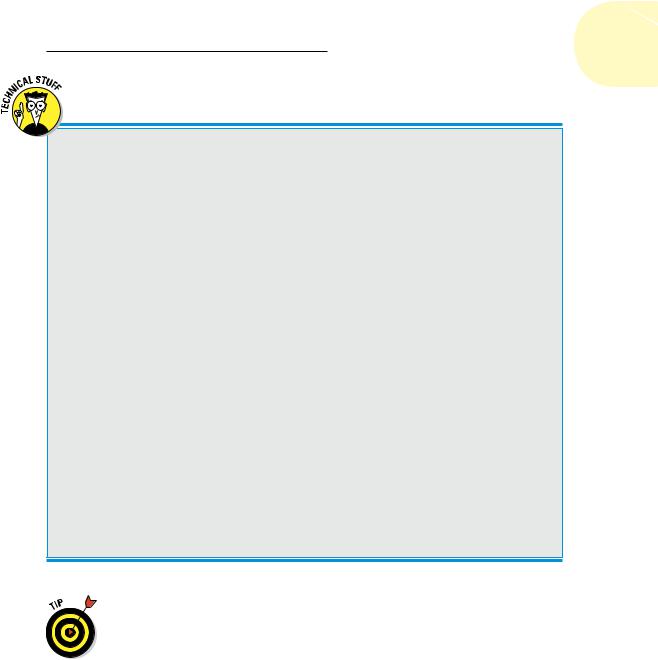
Chapter 2: Le Tour de AutoCAD 2013 |
25 |
Profiling your display
The illustrations and descriptions in this chapter and throughout the book show the default configuration of the AutoCAD 2013 Drafting & Annotation workspace — that is, the way the screen looks if you use the standard version of AutoCAD 2013 (not a flavored version, such as AutoCAD Architecture 2013 or AutoCAD Mechanical 2013) and don’t change any display settings. You can change workspaces by clicking either the Workspace Switching button on the status bar or the Workspace drop-down menu on the Quick Access Toolbar, and then choosing a different workspace from the menu. You can change the appearance of the workspace itself with settings on the Display tab of the Options dialog box (click the Application button, and then click Options at the bottom of the Application Menu) and by dragging toolbars and other screen components.
The main change from AutoCAD’s default settings that we make for this book is to configure the drawing area background to be white because the figures show up better that way when printed in the book. The default background color in both AutoCAD 2013 and
AutoCAD LT 2013 is dark gray, but many longtime users prefer a pure black background because they believe there’s less glare that way. (This is much less of an issue with LCD flat-panel displays.) You may want to set a black or a white background on your own system or stay with the default gray background — it’s your choice, and there’s no right or wrong way. Some AutoCAD object colors show up better on a light background, and some are better on a black one.
You can reset the default AutoCAD 2013 color scheme from the Options dialog box Display tab. Click Colors to open the Drawing Window Colors dialog box, and then click the Restore Classic Colors button. AutoCAD 2013 includes a couple of skinlike color schemes, also accessible from the Display tab of the Options dialog box. Designed to enhance the look of the Ribbonbased interface and ingeniously named Light and Dark, the differences between them are pretty subtle and apply to Windows elements (such as the title and taskbar), not to AutoCAD elements like crosshairs or background colors.
Slick as they are, navigating Ribbon panels and browsing through the Application Menu aren’t always the most efficient way of doing things. When you want to get real work done, you need to combine the Ribbon panels with other methods — especially entering options at the keyboard or choosing them from the right-click menus. We show you how throughout this book.
And They’re Off: AutoCAD’s Opening Screens
In addition to the Drafting & Annotation workspace, a few additional preconfigured workspaces are available from the Workspace Switching button. However, for most of this book, we stick with the out-of-the-box Drafting & Annotation workspace (the exception is Part V, which deals with 3D modeling), and we recommend you do the same as you read along.
www.it-ebooks.info
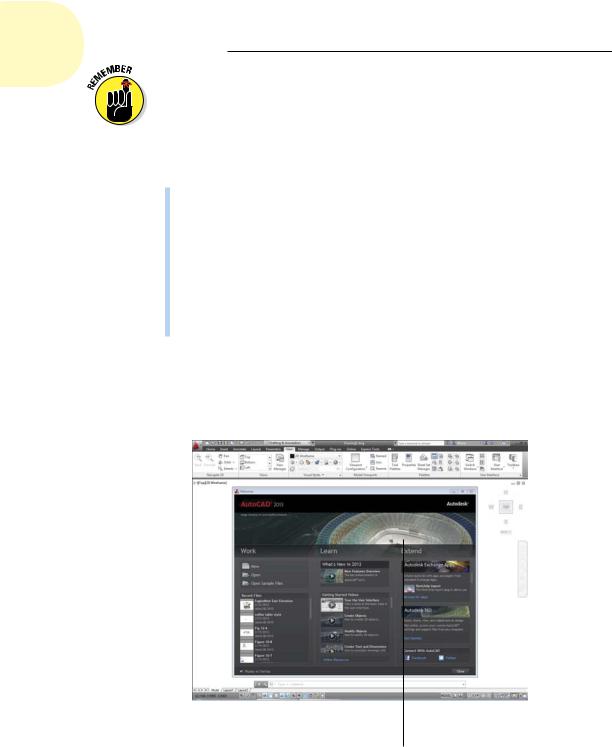
26 Part I: AutoCAD 101
A workspace is a collection of menus, palettes, toolbars, and/or Ribbon panels tailored for specific tasks, such as 3D modeling or 2D drafting.
After you switch workspaces, AutoCAD remembers which one you last used and opens in that one. Four standard workspaces are created when you install AutoCAD 2013 (only two come with AutoCAD LT 2013):
Drafting & Annotation: This workspace (shown in Figure 2-1) is configured for a 2D drafting environment, with Ribbon tabs and panels optimized for technical drawing in two dimensions.
3D Basics: This workspace is designed to help you get your feet wet with 3D modeling in AutoCAD 2013. It leaves out the Solid, Surface, and Mesh object creation tabs, and provides simplified panels in the other tabs. We cover modeling in 3D in Part V of this book, and there we use (and recommend that you do the same) the full 3D Modeling workspace Ribbon. This workspace isn’t included in AutoCAD LT because LT doesn’t do 3D.
Application button |
|
|
|
|
|
|
||||
In-canvas viewport controls |
Title bar |
|
||||||||
|
Quick Access toolbar |
|
|
InfoCenter |
|
|||||
|
|
|
|
|
|
|
|
|
|
|
|
|
|
|
|
|
|
|
|
|
|
|
|
|
|
|
|
|
|
|
|
|
|
|
|
|
|
|
|
|
|
|
|
|
|
|
|
|
|
|
|
|
|
|
|
|
|
|
|
|
|
|
|
|
|
|
|
|
|
|
|
|
|
|
|
|
|
|
|
|
|
|
|
|
|
|
|
|
|
|
|
|
|
|
|
|
|
|
Status bar Command window |
Navigation bar |
Welcome screen
Figure 2-1: Where’s my AutoCAD?: The AutoCAD 2013 Drafting &
Annotation workspace.
www.it-ebooks.info
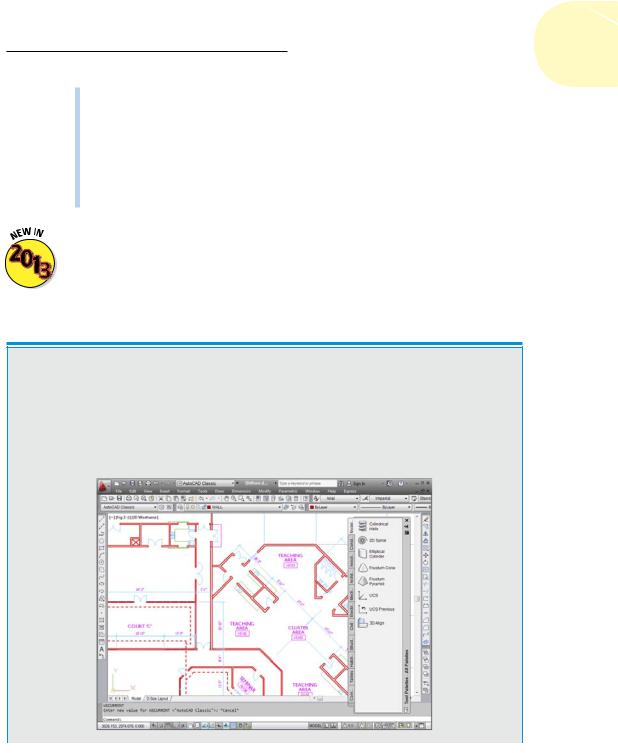
Chapter 2: Le Tour de AutoCAD 2013 |
27 |
3D Modeling: This Ribbon-based workspace is configured for a 3D modeling environment, with navigation, visualization, and modeling tools suitable for working in 3D. This workspace isn’t included in AutoCAD LT, either.
AutoCAD Classic: This workspace is configured for a 2D drafting environment, with toolbars and tool palette arrangements similar to those in AutoCAD 2008 and earlier. In AutoCAD LT, this workspace is called AutoCAD LT Classic.
AutoCAD 2013 added the Welcome screen, as shown in Figure 2-1. It appears when you first launch AutoCAD, and contains a number of quick links to recent drawings, What’s New and Getting Started tutorials, and so on. If (or more likely, when) you begin finding it to be irksome it can be turned off.
In fact, if you’re using a computer that belongs to someone else, such as a school or office, you will probably find that it has already been turned off.
Going for that classic look
Like it or not, the Ribbon-based user interface isn’t going away any time soon. We didn’t care for the 2D Drafting & Annotation workspace when it first showed up in AutoCAD 2008, but thanks to the Ribbon, we’re now more or less
sold on it. AutoCAD 2013’s Drafting & Annotation workspace is where we spend most of our time, and that’s what nearly all the figures in this book (including the figure here) show.
(continued)
www.it-ebooks.info
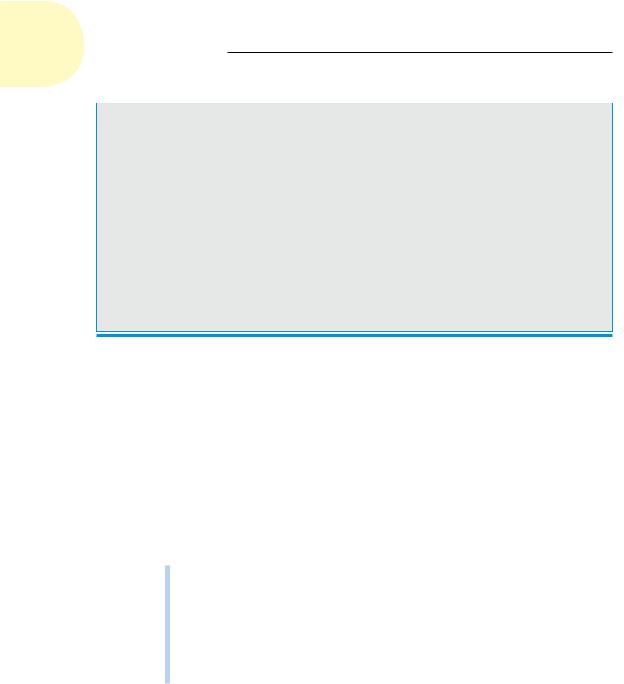
28 Part I: AutoCAD 101
(continued)
Unlike the Microsoft Office 2007 suite, which dragged longtime users kicking and screaming into the new Fluent User Interface (except for one of us who went back to Office 2003 with the Microsoft Compatibility Pack), AutoCAD users have the option of staying with the old interface. The easiest way to go back to the future is to switch workspaces by using (what else?) the Workspace Switching button on the status bar, or the Workspace drop-down menu on the Quick Access Toolbar. Select AutoCAD Classic, and presto! — this is (almost) your father’s AutoCAD! You end up with a menu bar; some familiar-looking toolbars docked to the top, left,
and right sides of the drawing area; and a floating tool palette near the middle of the display.
The Ribbon-based interface lets you add bits of the old one, too. You can display the classic drop-down menu system by clicking the down arrow at the right end of the Quick Access Toolbar and choosing Show Menu Bar. You can also stay mostly in the Ribbon but display your favorite classic toolbars at the same time. Just click Toolbars on the Windows panel of the View tab, click AutoCAD to display the entire list of toolbars, and then select the ones you want.
Running with Ribbons
Whether you’re running AutoCAD 2013 in Windows 7, Vista, or XP, most of the AutoCAD default screen (refer to Figure 2-1) is pretty different from traditional Windows fare. Yes, you have title bars and a status bar, but the rest of the interface might look foreign. We cover the familiar stuff first.
A hierarchy of title bars
Like most Windows programs, AutoCAD has a title bar at the top of its application window, which reminds you which program you’re in (not that you’d ever mistake the AutoCAD 2013 window for, say, FreeCell — or even AutoCAD 2008!). After you open a drawing or start a new one, it shows the filename.
On the program’s title bar: At the right side of the program title bar is the standard set of three Windows control buttons: Minimize, Maximize/ Restore, and Close.
On the file’s title bar: Each nonmaximized drawing window within the AutoCAD program window has its own title bar, as shown in Figure 2-2. You can use the control buttons on a drawing window’s title bar to minimize, maximize/restore, or close that drawing instead of the entire AutoCAD program.
As in other Windows programs, if you maximize a drawing’s window, it expands to fill the entire drawing area. In the AutoCAD 2013 Drafting & Annotation workspace, a maximized drawing window’s control buttons have migrated south, from the menu bar (which isn’t there anymore) to the upperright corner of the drawing area itself. To un-maximize (restore) the drawing so that you can see any other drawings that you have open, click the lower Restore button.
www.it-ebooks.info
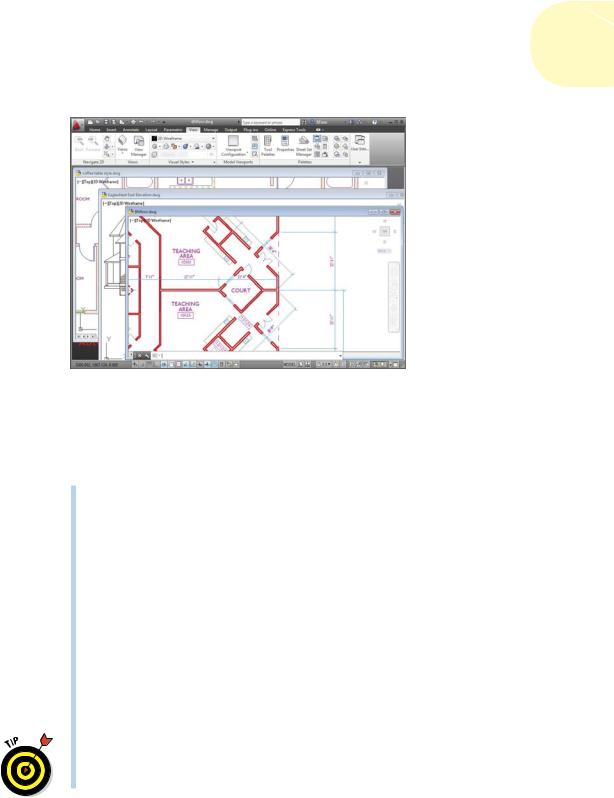
|
|
|
Chapter 2: Le Tour de AutoCAD 2013 |
29 |
|||
|
|
|
|||||
Drawing window title bar |
Drawing window control buttons |
|
|||||
|
|
|
|
|
|
|
|
|
|
|
|
|
|
|
|
Figure 2-2: The AutoCAD screen with several windowed drawings in view.
The program title or drawing name is centered in the title bar instead of being off to the left. The AutoCAD title bar also has these couple of devices added to it:
InfoCenter: Located at the right side of the program title bar, this is Information Central for AutoCAD. Type a keyword and then click the binoculars for more information, or sign in to your Autodesk account if you have one. The next two buttons both open the Autodesk Exchange for AutoCAD window. The button that looks like a half-positive, halfnegative X opens the Exchange window home page with links to What’s New videos and the Autodesk Subscription Center (alas, not included in the price of admission). You can download free or inexpensive add-on programs from the Apps page. Clicking the question mark button in the InfoCenter area, as you can probably figure out for yourself, opens the Exchange window Help page.
Quick Access Toolbar: This permanent toolbar (the only one common to all workspaces) contains frequently used commands in an easily accessible location. You can add and remove tool buttons by clicking the down arrow at the right end of the Quick Access Toolbar and selecting or deselecting the ones you want to add or remove, respectively.
If you’re floundering around looking for the commands you used to be able to find, a life preserver is hiding in the drop-down menu at the right end of the Quick Access Toolbar. Click Show Menu Bar, and the old familiar classic menu appears above the Ribbon.
www.it-ebooks.info

30 Part I: AutoCAD 101
Making choices from the Application Menu
The Application Menu is accessible from all workspaces. The AutoCAD 2013 Application Menu follows the Microsoft FUI guidelines in placing file management commands here, and all drawing and editing commands on the Ribbon. The Application Menu is divided into nine categories, as follows:
New: Create a new drawing from a list of templates or create a new sheet set (a named collection of drawing layouts derived from one or more drawing files that can be printed or archived at one go). Sheet sets are included in AutoCAD 2013 and LT 2013, but we don’t cover them in
this book.
Open: Open an existing drawing or sheet set for editing, or import data from a MicroStation DGN file into a new AutoCAD drawing.
Save: Save the current drawing in the current location; if the current drawing hasn’t been saved, you’re prompted for a filename and a location.
Save As: Save the current drawing to a new filename and/or location and make the newly named or located file the current drawing. Also save the drawing as a template (DWT) or standards (DWS) file, or export a paper space layout to a new drawing.
Use the DWG Convert tool to save drawing files to different DWG formats as far back as AutoCAD 2000. Yes, you can already do that with the regular SAVEAS command, but DWG Convert can do batch conversions of groups of files and entire file folders.
Export: Save the current drawing to a variety of Design Web Format (DWF) files, a PDF, a DGN, or several other CAD file formats. We discuss many of these formats in Chapters 18 and 20.
AutoCAD 2013 exports to FBX format (that’s one we don’t discuss in this book). FBX is specifically designed to export lights and materials — even animation data (and haven’t we come a long way from lines and circles?) from AutoCAD drawings to more specialized 3D programs like Autodesk Maya or Max. In short: If you need this format, you already know about it.
Publish: Send a 3D model to an outside 3D printing service or create an archived sheet set. (AutoCAD LT doesn’t support 3D.) Use eTransmit to create a package that includes all files referenced by the selected drawings, or e-mail the current drawing by using your configured e-mail client.
Print: Print a single drawing or batch plot multiple drawings, create or modify named page setups, and manage plotters and plot styles. We cover most of these operations in Chapter 16.
Drawing Utilities: Set file properties or drawing units; purge unused blocks, layers, and styles from the current drawing; and audit or recover damaged drawings.
www.it-ebooks.info
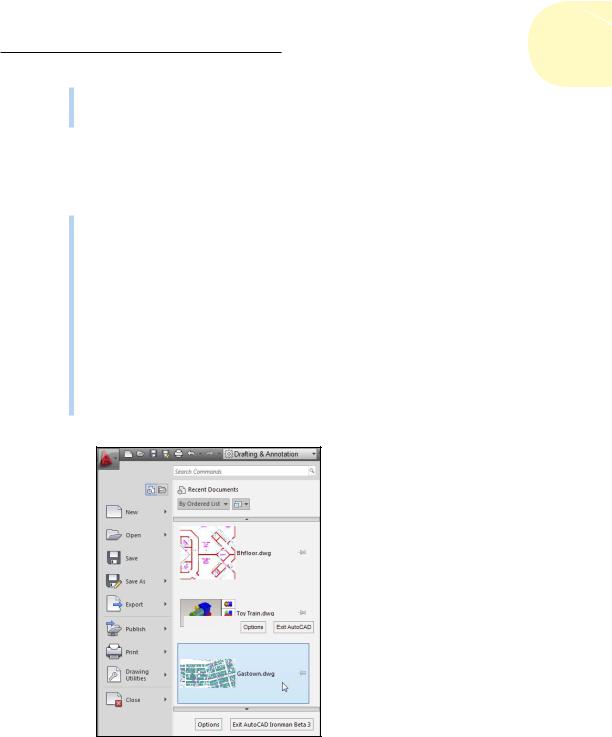
Chapter 2: Le Tour de AutoCAD 2013 |
31 |
Close: Close the current drawing or close all drawings. If any drawings have been changed, you’re prompted to save before AutoCAD closes the file.
But wait! There’s more under the Big Red A
In addition to the Application Menu’s actual file menu items, a few other features are worth a mention:
Recent Documents: If you choose this option, the right pane displays a list of drawings that you recently edited but that aren’t currently open. You can show them in a simple list or as thumbnail images, as shown in Figure 2-3. You can also pin them to stop them from scrolling off the list. Naturally enough, clicking one of the icons opens the drawing.
Open Documents: Choose this option to see what’s already open, and click an item to switch to it. This is equivalent to pressing Alt+Tab to switch between open documents in any Windows program and works the same basic way as the Quick View Drawings feature, described in the “Looking for Mr. Status Bar” section, later in the chapter.
Options: Click this button to open the Options dialog box, where you can make hundreds of system settings. You can also open Options by typing OP (the alias for the OPTIONS command).
Figure 2-3: Find that drawing you know that you worked on yesterday.
www.it-ebooks.info
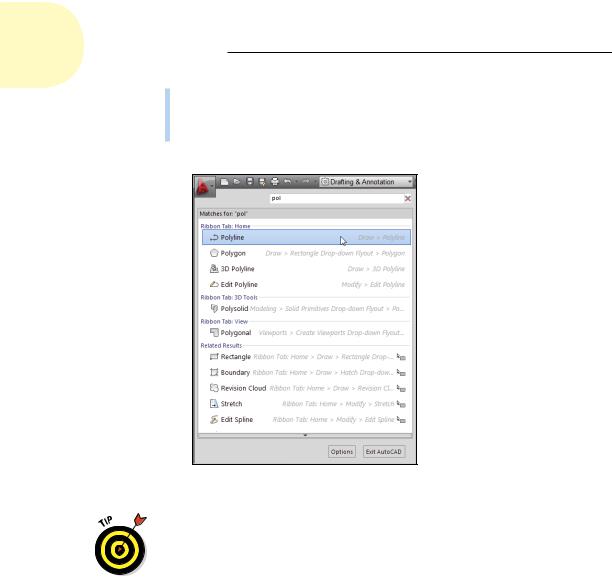
32 Part I: AutoCAD 101
Search: If you’re not sure of a command name or you want help on a topic, just start typing in the Application Menu’s search bar. AutoCAD 2013 very quickly displays a categorized list, complete with links to start commands or to access the online help (see Figure 2-4).
Figure 2-4: If you can’t find it in the Ribbon or tool buttons, just start typing!
A quick way to close AutoCAD is to double-click the big red A. AutoCAD asks if you want to save unsaved drawings, and then shuts down.
Unraveling the Ribbon
The primary interface element in the Drafting & Annotation, 3D Basics, and 3D Modeling workspaces is the Ribbon, an adjustable area that contains different collections of tabbed, task-oriented collections of panels. Some panels — those marked with a little black triangle on the panel label — have more tools concealed on a slideout (see Figure 2-5). Click the panel label to open the slideout. You can click the pushpin icon to pin the slideout open — otherwise, it will slide away home after you click a button.
In AutoCAD 2013, you can click and drag a Ribbon panel and pull it into the drawing area. So if, for example, you find yourself doing a whack of dimensioning, but you also want to move away from the Annotate tab to other Ribbon tabs, you can drag the Dimensions panel into the drawing, and it will stay put, even as you switch to other panels or tabs. Just be sure to put it back where it came from when you’re finished with it (as your mom used to say).
www.it-ebooks.info
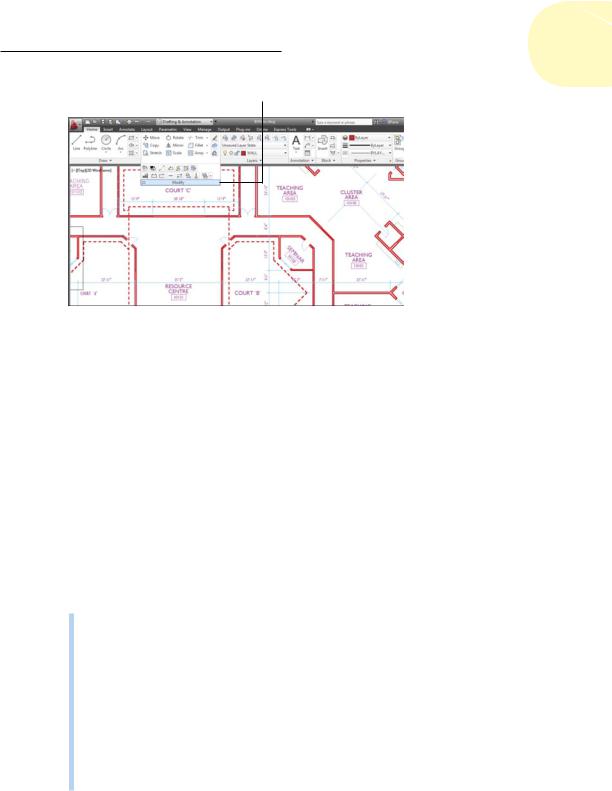
Chapter 2: Le Tour de AutoCAD 2013 |
33 |
Panel slideout
Figure 2-5: More tools than you can wave a Ribbon at.
Autodesk’s programmers see the Ribbon as an alternative way of interacting with the program. Theoretically, the Ribbon eliminates the need for menus and separate toolbars, although the change-averse may think otherwise. The Ribbon is fully customizable, but we don’t get into customizing AutoCAD
in this book. If you want to find out more, click Customization Guide in the AutoCAD 2013 online help Home page.
By default, the Ribbon is docked at the top of the screen, but it can be docked against any edge, anchored to the left or right side of the AutoCAD window, or floated. To gain some screen space, you can click the little white button to the right of the last tab on the Ribbon’s tab bar to reduce the amount of space the Ribbon takes, or use the drop-down menu next to the little white button to tailor the Ribbon’s display to just the way you want it.
Instead of menus of grouped commands like Draw, Modify, Insert, and so forth, the tabs are organized by task as follows:
Home: The Home tab contains Draw, Modify, Layers, Annotation, Block, Properties, Groups, Utilities, and Clipboard panels. Some panels may be displayed as collapsed, depending on your screen resolution. As an
example, the five panels at the right end of the Annotate tab in Figure 2-5 are in a collapsed state. We cover most of the commands in these panels in other parts of the book.
Insert: This tab groups Block and Reference panels, as well as Point Cloud tools, Import commands, and a series of commands for working with nongraphical information, including attributes, fields, and data links. We do cover blocks (Chapter 17) and external references (Chapter 18), but point clouds, importing, and data tools are beyond the scope of this book and aren’t covered.
www.it-ebooks.info
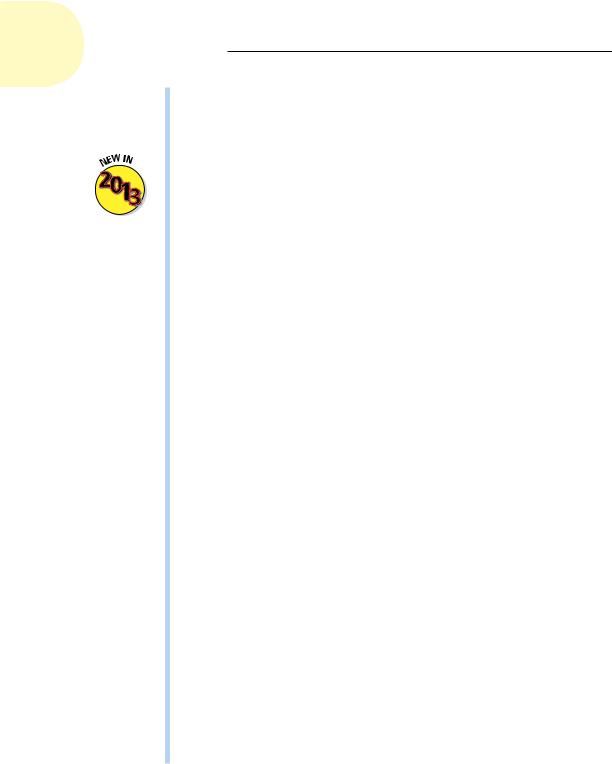
34 Part I: AutoCAD 101
Annotate: The Annotate tab expands on the minimalist Annotation panel on the Home tab, with many more options for creating text, dimensions, leaders, and tables, as well as markup functions and a few annotation scaling tools.
Layout: This tab includes a series of panels used to create and modify paper space layouts, and to create 2D drawing views from 3D models. We cover paper space layouts in Chapters 4 and 5 and introduce 3D in Part V.
Parametric: This tab is home for one of AutoCAD 2013’s most powerful features — parametric drawing. You can apply geometric or dimensional parameters or constraints to drawing objects so that, say, two circles are always concentric or the length of a rectangle is always twice its width. (AutoCAD LT is limited in this department: You can modify or delete existing constraints, but you need the full version of AutoCAD to create them.) We introduce parametric drawing in Chapter 19.
View: The View tab contains tools and panels for controlling drawing display, working with viewports, loading various palettes, and organizing Windows functions such as cascading open files or displaying different parts of the application window. We explain most of the features on this tab later in the book.
Manage: This tab contains panels that access the Action Recorder, CAD Standards (neither of which is in AutoCAD LT), and a set of drawing management and customization tools. We don’t cover anything on the Manage tab in this book.
Output: Panels on this tab allow you to get those drawings off your hands by printing (also known as plotting), publishing, exporting to PDF or DWF files, or simply sending them electronically to others. We cover some of these functions in Chapter 16.
Plug-Ins: This tab is present in both AutoCAD and AutoCAD LT, although in LT, there is only one panel instead of two. Both versions have a Content panel with a single Explore button that runs the new Content Explorer tool. After you let it index your file folders, Content Explorer can winnow through all your drawings looking for specific blocks, layers, layouts, and even text strings. AutoCAD itself also has an Inventor Fusion panel, from which you can edit solids and surfaces in a strippeddown version of Autodesk Inventor.
Online: This tab is also present in both AutoCAD and AutoCAD LT, and this time, the tabs are identical. Most of the buttons fire up a login screen for the AutoCAD WS service. With an AutoCAD WS account, you
can upload drawings to a secure website, and then access them on your iPad (you do have an iPad, right?), Android device, or on any computer with a web browser. You can also invite non-AutoCAD users to view and mark up your drawings, using a standard web browser.
www.it-ebooks.info
